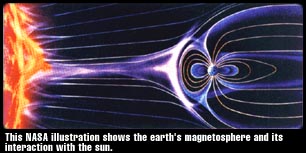|
|
|||||
|
|
|||||
|
The Sun-Earth Connection
Sunspots also have an indirect but significant impact on life here on earth. As early as the nineteenth century, scientists noticed that high levels of activity on the sun, like flares and sunspots, were followed shortly by strong fluctuations in magnetic instruments on earth. They wondered what caused these changes. Scientists today have discovered a lot about the way the sunspots affect the earth. According to Dearborn, "The sunspot itself, the dark region on the sun, doesn't by itself affect the earth. However, it is produced by a magnetic field, and that magnetic field doesn't just stop, it comes to the surface and expands out above the surface...." Hot material called plasma near a sunspot interacts with magnetic fields, and the plasma can burst up and out from the sun, in what is called a solar flare. Energetic particles, x-rays and magnetic fields from these solar flares bombard the earth in what are called geomagnetic storms. When these storms reach earth, they affect us in many ways. |

|
As Fisher describes it, "The earth has a protective cocoon of magnetic field called the magnetosphere, and it normally protects us from the magnetic particles of the solar wind, and the other energetic particles in the solar wind. But during a coronal mass ejection we actually have a chunk of the sun that breaks away and hits the earth's magnetosphere, and disturbs it, and this disturbance shows up as aurorae." |
|
|
|||||
|
|
|||||
|
|

